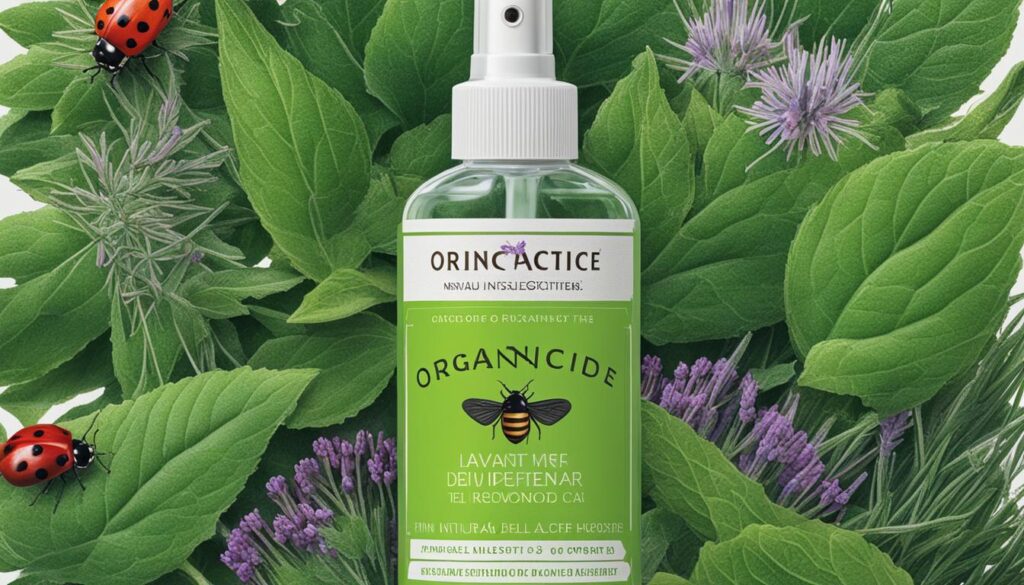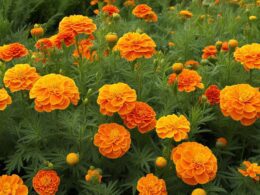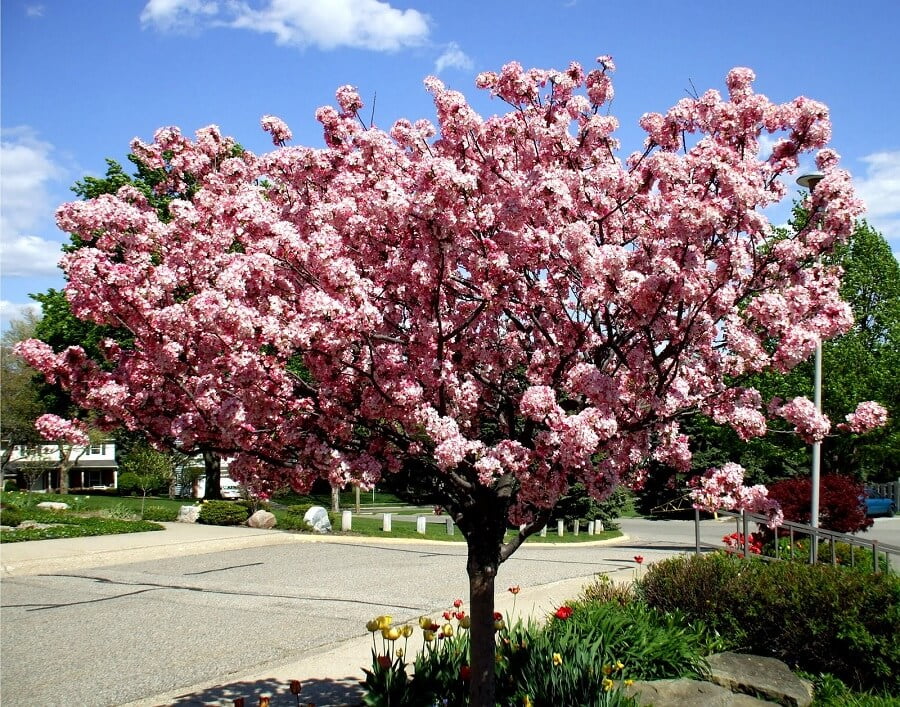Soap spray is a highly effective and natural solution for controlling pests on your indoor plants. It is made from a simple mixture of liquid soap and water, providing a non-toxic and eco-friendly alternative to chemical insecticides. By suffocating and dehydrating common pests such as aphids, mealybugs, thrips, and spider mites, soap spray helps promote robust and healthy growth in your indoor garden. In this natural care guide, you will learn how to make and apply soap spray, as well as other household ingredients for pest control.
Key Takeaways:
- Soap spray is an effective and natural solution for pest control on indoor plants.
- It is made from a simple mixture of liquid soap and water.
- Soap spray suffocates and dehydrates common pests on indoor plants.
- Proper application and precautions are important for successful pest control.
- There are other household ingredients that can also be used for pest control.
What is Insecticidal Soap?
Insecticidal soap is a natural and non-toxic method for controlling pests on your indoor plants. When other methods like hand-picking or spraying water aren’t effective, insecticidal soap provides an eco-friendly solution. It works by suffocating pests and disrupting their cell membranes, effectively eliminating common indoor plant pests such as aphids, mealybugs, thrips, and spider mites.
An insecticidal soap can be easily made at home using just a few simple ingredients. By mixing liquid soap with water, you can create a solution that is safe to use both indoors and outdoors. Commercial insecticidal soaps are also available if you prefer a ready-to-use option. Regardless of whether you make your own or purchase one, insecticidal soap offers a natural and non-toxic method for pest control.
Why choose insecticidal soap?
- It is natural and non-toxic, making it safe for you, your plants, and the environment.
- It effectively controls a wide range of indoor plant pests.
- It is easy to make at home using readily available ingredients.
- It can be used both indoors and outdoors.
- It is a cost-effective alternative to chemical insecticides.
Tips for using insecticidal soap:
- Ensure your plants are well-watered and not under stress before applying the soap.
- Avoid spraying on hot, sunny days to prevent leaf injury.
- Spray the soap solution directly on the pests, covering both the tops and bottoms of leaves.
- Repeat the application once a week for at least 4 weeks to control severe infestations.
- Test the solution on a small area of the plant before applying to the entire plant to check for leaf damage.
Ingredients for Homemade Insecticide
In order to make homemade insecticide, you’ll need a few key ingredients. The first option is liquid dish soap, which is commonly found in most households. Look for a mild soap without additives or detergents, as these can be harmful to your plants. Another option is castile soap, such as Dr. Bronner’s pure-castile liquid soap, which is made from organic oils and does not contain harsh chemicals. Castile soap is a great choice for those seeking a more natural and eco-friendly solution.
Aside from soap, you’ll also need water to create the insecticidal spray. It’s important to use distilled or bottled water if your tap water is high in minerals, as these minerals can reduce the effectiveness of the soap. Additionally, you can optionally include vegetable oil in your homemade insecticide. Vegetable oil helps the solution stick to the plants, enhancing its effectiveness. However, if you plan to store the insecticide for longer periods of time, it’s best to omit the oil.
Ingredients for Homemade Insecticide:
- Liquid dish soap or castile soap
- Water (distilled or bottled if tap water is high in minerals)
- Optional: Vegetable oil for enhanced sticking power
Creating your own insecticide at home is not only cost-effective but also allows you to have control over the ingredients. By using mild liquid dish soap or castile soap, along with water and optional vegetable oil, you can make a safe and effective solution for your indoor plants.
How to Make Organic Insecticide at Home
Making your own organic insecticide at home is a simple and cost-effective way to control pests on your indoor plants. By using a homemade soap solution, you can effectively eliminate pests without the use of harsh chemicals. Here’s a step-by-step guide to making your own organic insecticide:
Mixing the Ingredients
To make the organic insecticide, you will need a gallon of water, 2 1/2 tablespoons of pure-castile liquid soap, and optionally 1 tablespoon of vegetable oil. In a gallon-size spray container, combine the soap and oil (if using) with the water. Shake the mixture well to ensure it is thoroughly blended.
Proper Application
Before applying the organic insecticide, it’s important to ensure that your plants are well-watered and not under stress. Spray the soap solution directly on the pests, covering both the tops and bottoms of the leaves where the pests are commonly found. Be sure to spray only where pests are visible, as the insecticide works on direct contact and loses effectiveness once dry.
Frequency of Application
To effectively control pests, it is recommended to spray your plants with the organic insecticide once a week for a duration of 4 weeks or more for severe infestations. However, if you have smaller plants or fewer pests, you can scale down the recipe and use 2 teaspoons of soap for every 1 quart of water. This will ensure proper pest control without overwhelming your plants.
By following these simple steps, you can create your own organic insecticide and protect your indoor plants from pesky pests. This homemade solution is safe to use and provides an eco-friendly approach to pest control in your home garden.
How to Apply Insecticidal Soap to Your Plants
Applying insecticidal soap to your plants is a simple and effective way to control pests without relying on harsh chemicals. By following these steps, you can ensure proper application and maximize the effectiveness of the soap spray.
1. Prepare your plants: Before applying the insecticidal soap, make sure your plants are well-watered and not under stress. This will help them better tolerate the treatment and minimize the risk of leaf injury.
2. Choose the right time: It’s important to avoid spraying on hot, sunny days, as the soap may cause leaf injury when it dries too quickly. Opt for a cooler time of day, or choose a cloudy day for application.
3. Spray the pests: Spray the soap solution directly on the pests, covering both the tops and bottoms of leaves where pests are commonly found. Be sure to spray only where pests are visible, as insecticidal soap works on direct contact with pests.
4. Repeat the process: For best results, repeat the spray once a week for a duration of 4 weeks or more for severe infestations. This will help break the pest life cycle and ensure that any newly hatched pests are also controlled.
Remember to be cautious of susceptible plants that may be sensitive to soap. Conduct a test spray on a small area before applying the soap spray to the entire plant. By following these guidelines, you can effectively apply insecticidal soap and achieve successful pest control in your indoor garden.
Other Household Ingredients for Pest Control
In addition to soap spray, there are other household ingredients that you can use to effectively control pests in your indoor garden. These ingredients are safe, natural, and readily available, making them a convenient and eco-friendly choice for pest control.
1. Dishwashing Liquid or Castile Soap:
Mixing a small amount of dishwashing liquid or castile soap with water can create a solution that repels leaf-sucking pests like spider mites, mealybugs, and aphids. Simply combine a teaspoon of soap with a gallon of water and spray it on the affected plants. This solution is effective in deterring and eliminating pests while keeping your plants safe.
2. Cinnamon:
If you’re dealing with fungus gnats in your indoor garden, sprinkle some cinnamon powder over the soil. Cinnamon acts as a natural fungicide and insect repellent, helping to deter these pesky pests. Reapply the cinnamon as needed to maintain its effectiveness.
3. Vegetable Oil:
For soft-bodied pests like aphids and scales, you can use vegetable oil to suffocate and control them. Mix a tablespoon of vegetable oil with a quart of water, shake well, and spray it onto the affected plants. The oil will coat the pests and disrupt their ability to breathe, effectively controlling their population.
Tips for Using Natural and DIY Insecticides
When it comes to natural and DIY insecticides, there are a few tips and considerations to keep in mind for effective and eco-friendly pest control in your indoor garden. By following these guidelines, you can ensure the health and vitality of your plants while effectively managing pests.
Avoid Overuse
While natural insecticides are generally safer than chemical alternatives, it’s important to use them sparingly. Overuse can lead to residue build-up on leaves, potentially causing leaf damage or interfering with the plant’s natural processes. Apply the insecticides only when necessary, targeting areas where pests are visible, and avoid spraying excessively on unaffected areas.
Consider Alternative Methods
While natural insecticides can be effective, it’s always worth exploring other pest control methods before resorting to sprays. Hand-picking pests, using physical barriers, or introducing beneficial insects can often provide effective and sustainable solutions. Additionally, maintaining good plant health through proper watering, fertilization, and regular inspections can help prevent pest infestations in the first place.
Test Before Widespread Application
Prior to applying any natural or DIY insecticide to your plants, it’s important to conduct a test spray on a small area. This will help you determine if the solution may cause any adverse effects or leaf damage. Wait for a few days to observe the plant’s response before applying the insecticide to the entire plant. This precautionary step can save you from damaging your plants and allows you to fine-tune the concentration or application technique if needed.
By following these tips, you can effectively use natural and DIY insecticides while maintaining an eco-friendly approach to pest control in your indoor garden. Remember to always read and follow the instructions provided with commercial insecticides or consult reliable sources for guidance when making your own. Using these methods responsibly will help you keep your indoor plants healthy and free from pests.
Conclusion
Soap spray is a highly effective and natural solution for controlling pests on your indoor plants. Its simplicity, affordability, and non-toxic nature make it an ideal choice for maintaining a healthy home garden. By suffocating and dehydrating pests upon contact, soap spray provides an eco-friendly alternative to chemical insecticides.
Making homemade soap spray is easy – just mix liquid soap and water. Apply the solution directly on the pests, covering both sides of the leaves where pests are commonly found. With regular use, soap spray can help promote robust and healthy growth in your indoor plants.
Remember to properly prepare your plants before applying the soap spray. Water them regularly and avoid spraying on burned or stressed leaves. Remove heavily infested leaves and dispose of them properly. Keep in mind that soap spray works on direct contact with pests, so make sure to spray only where pests are visible.
Incorporating soap spray into your pest control routine is a safe and natural way to protect your indoor plants. By following proper application techniques and precautions, you can enjoy the benefits of a pest-free and thriving home garden.
Can the Soap Spray for Indoor Plants Also Help with Pest Control?
Yes, the soap spray on indoor plants not only helps to keep them clean but can also be effective in controlling pests. Its natural ingredients make it a safe and non-toxic option for indoor plant care. Simply spray on indoor plants to deter pests and keep your plants thriving.
FAQ
What pests can soap spray control on indoor plants?
Soap spray can effectively control common pests such as aphids, mealybugs, thrips, and spider mites.
How does soap spray work as a natural insecticide?
Soap spray suffocates and dehydrates pests upon contact, providing a non-toxic and eco-friendly alternative to chemical insecticides.
What ingredients are needed to make homemade insecticide?
Homemade insecticide can be made using liquid dish soap or castile soap, water, and optionally vegetable oil.
How can I make organic insecticide at home?
Mix a gallon of water with 2 1/2 tablespoons of pure-castile liquid soap and 1 tablespoon of vegetable oil (optional) in a spray container. Shake well before use.
How should I apply insecticidal soap to my plants?
Spray the soap solution directly on the pests, covering both the tops and bottoms of leaves where pests are commonly found. Avoid spraying on hot, sunny days and only where pests are visible.
What are some other household ingredients for pest control?
Dishwashing liquid or castile soap mixed with water can repel leaf-sucking pests. Cinnamon can deter fungus gnats, and vegetable oil can suffocate soft-bodied pests. Diatomaceous earth, garlic sprays, and chilli sprays can also be effective against pests.
What are some tips for using natural and DIY insecticides?
Water your plants regularly, remove heavily infested leaves, apply insecticides out of direct sunlight, keep pets and children away during spraying, and conduct a test spray before widespread application. Use natural insecticides sparingly.
How effective is soap spray for indoor plants?
Soap spray is a highly effective and natural solution for controlling pests on indoor plants, providing a simple, low-cost, and eco-friendly method of pest control.












